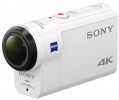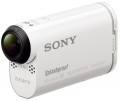Thread 1/4" (for tripod)
The presence of a
1/4" threaded socket on the camera body. It is this size that is standard for modern
tripods and is used in most of these devices. So this feature allows you to mount the camera on a tripod without using adapters and other additional equipment.
Dust-, moisture-proof camera
The level of dust and water protection provided by the body of the camera itself. Most action cameras are designed for recording in extreme conditions, but the level of protection of each model can vary significantly — from the ability to shoot in the rain, to full tightness, allowing for a long immersion under water.
To characterize the security level of the camera, the international IP classification is used. Each device is assigned a code of the form IPXX, where instead of the first X — the level of protection against the ingress of foreign objects (including dust), and instead of the second X — the level of protection against the ingress of water.
Levels of protection against dust and foreign objects in modern action cameras are never lower than 5 — lower protection classes would provide unacceptably large gaps in the body. Specifically, level 5 provides that dust can get inside in small quantities, but does not affect the performance of the device. A higher level — 6 — provides full dustproof.
To characterize the level of protection from water, the following classification is used:
0 — no protection;
1 — drops of water falling at a right angle relative to the operating position of the device cannot cause dangerous consequences;
2 — protection against drops falling on the equipment at an angle of up to 15°;
3 — at an angle up to 60° (splash protection, minimum rain protection);
4 — protection from rai...n with strong wind;
5 — protection against water jets falling at any angle (water jets, for example, from a hose or heavy rain cannot harm the device);
6 — from temporary flooding;
7 — from temporary immersion under water to a depth of not more than 1 metre;
8 — from prolonged diving to depth (maximum time and depth are specified by the manufacturer separately).
In some cases, a model may only be IP-certified for one type of protection (only against sand or water). In this case, instead of the second parameter, simply X is put. So, for example, IPX6 security means that the camera is protected from temporary flooding and heavy rain, but the level of protection from dust is not defined and, accordingly, is not certified.
It is important to note that this parameter characterizes the protection of the camera itself, but does not take into account the capabilities of protective cases. Do not confuse it with the protection of the outer case, which sometimes comes with the device (see "Dust-, moisture-proof of case").
HD (720p)
The ability of the camera to record HD video (720p).
The official HD specification provides a resolution of 1280x720. However, in action cameras, there may be resolutions slightly different from this parameter, for example, 1080x720 or 1440x960. Anyway, HD is the most modest of today's high-definition standards, which, nevertheless, provides a fairly clear and detailed image.
Another important parameter given in this paragraph is the frame rate. The higher it is, the smoother the movement in the frame will be, and the details in dynamic scenes will be visible clearly. Technically,
30 fps or even less is enough for video, but
60 fps is considered the perfect value — at this frame rate, motion blur becomes almost imperceptible and at the same time the size of the captured files remains within reasonable limits. However, there are cameras on the market with higher frame rates at HD resolutions —
100 fps,
120 fps,
200 fps and even
240 fps. This speed is usually used for recording slow-motion video, but such a possibility needs to be specified separately.
Ultra HD (4K)
The ability of the camera to shoot Ultra HD 4K video.
This format covers several resolutions in which the horizontal frame size is approximately 4K pixels. The most popular in action cameras is 3840x2160 (twice the FullHD frame on each side), but there are other options — for example, 3840x1920, corresponding to an aspect ratio of 2:1. In general, 4K is a kind of successor to Full HD: among HD standards that surpass Full HD, UltraHD is the most popular, in particular, many advanced TVs are produced with 3840x2160 screens. On the other hand, this format is quite demanding in terms of processing power and memory, so it is relatively rare in action cameras, mainly among premium models.
Another important parameter given in this paragraph is the frame rate. The higher it is, the smoother the movement in the frame will be, and the details in dynamic scenes will be visible clearly. However, in UltraHD mode, most modern action cameras produce a very low frame rate — most often
30 fps, and in some models
24 fps or even
15 fps. This video is quite viewable, but fast movement in the frame may look blurry. There are cameras capable of shooting UltraHD at a solid speed of
60 fps — the blurring effect during such shooting is almost imperceptible. However, such a model cost is high.
Slow motion
Frame rate supported by the camera when
shooting in slow motion.
In general, such shooting is called “high-speed” because it is carried out at an increased frame rate (more than 60 fps). As a result, when played back at normal speed (60 fps and below), the video looks slow hence the name. This kind of slow-motion can be used just for fun, as an artistic technique, and even for scientific purposes — to capture movement that is too fast for the human eye. In any case, the higher the slow-mo frame rate, the more you can slow down the video and the more advanced the camera is in this regard. On the other hand, the higher the frame rate, the more performant the graphics part should be; and this, in turn, affects the price of the device, sometimes quite noticeably.
We also note that slow-mo shooting may be available only at certain resolutions, not always at maximum. These points can be directly specified in the specs of the action camera.
Digital stabilization
The presence of a digital (electronic) stabilization system in the camera design.
Any stabilization is intended to compensate for small juddering of the image that occurs due to the instability of the hold in the hands, vibrations from the motor or road roughness (when used in transport), etc.
Digital stabilization is carried out as follows: a reserve area is allocated along the edges of the sensor, which under normal conditions does not participate in the formation of the final image. If the device is being shaken, the camera electronics select certain parts of the image from the reserve and build the image in such a way that in the end, it remains stable.
Compared to other methods of stabilization, digital systems are extremely simple and reliable. Moreover, they are inexpensive and have almost no effect on the weight, dimensions, and price of the camera. At the same time, with this method of stabilization, the effective area of the image sensor is reduced, which can adversely affect the image quality and the amount of noise on it.
Optical stabilization
The presence of an optical stabilization system in the design of the camera.
Any stabilization is intended to compensate for small juddering of the image that occurs due to the instability of the hold in the hands, vibrations from the motor or road roughness (when used in transport), etc.
Optical stabilization is carried out by a system of movable lenses and gyroscopes in the camera lens; such a system monitors the vibrations of the device and adjusts the optics in such a way that the image falling on the sensor remains motionless.
The optical method is considered more advanced than the electronic method described above: it allows you to use the entire area of the image sensor, which contributes to good image quality. At the same time, the stabilization mechanism turns out to be quite complex and expensive, and often quite fragile. In addition, it increases the weight and dimensions of the entire device — not by much, but sometimes this may be important. And the miniaturization of such systems further affects the price. As a result, the presence of an optical stabilizer is most often a sign of a fairly advanced camera.
Megapixels
The number of megapixels in the action camera sensor, in other words, the resolution of this sensor(1 megapixel is 1 million photosensitive points).
There is an opinion that the higher the resolution, the better the image quality. It is true from the point of view that manufacturers are trying to install high-resolution sensors in advanced cameras. At the same time, there are no strict dependencies here, and from the technical point of view, the number of megapixels determines only the maximum image resolution that can be captured using this sensor. The quality of this picture will depend both on several features of the sensor itself (size, type, special design solutions), and the specs of the camera. So when choosing, you should focus not so much on the resolution of the image sensor, but on the general class of the camera and reviews with examples of footage.
Photo resolution
The maximum resolution at which the action camera can take photos. Specified in pixels horizontally and vertically.
This parameter is directly related to the resolution of the image sensor(see above): the total number of pixels in the photo, usually, corresponds to the number of pixels in the sensor. For example, a photo resolution of 4608x3456 corresponds to a sensor of 15925248 pixels, or approximately 16 megapixels. If the number of pixels in the photo is greater than the claimed resolution of the sensor, then the manufacturer uses software tricks that allow you to improve the photo resolution to a higher one than originally. This reduces the cost of devices but also affects the quality of images.
Theoretically, high-resolution images can provide good detail, but in fact, much depends on the specs of the sensor (primarily physical size) and image processing features.

